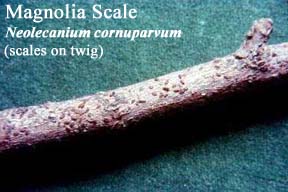Magnolia (Magnolia)
Plant Health Problems
Diseases caused by Fungi:
Leaf spot.
A variety of organisms can cause leaf spots on southern magnolias which are weakened by environmental stress. See Shade Trees.
Diseases caused by Physiological/Environmental Factors:
Weather-related problems.
Though our native magnolia, the Cucumbertree, is hardy here (and has no important pathogens), the southern magnolias which are often planted, frequently have extensive dieback or are killed when temperatures are below 0 F.
Insect Problems: Magnolia scale, Neolecanium cornuparvum. This is a brown soft scale that infests the lower branches of certain species of magnolia. This is a large scale, with mature females measuring up to ½" long. There is one annual generation and the young appear in August, settle on the branches and overwinter as oval dark brown nymphs covered with a bluish waxy bloom. Among the compounds registered for use against this pest in Connecticut are horticultural oil and imidacloprid . Control can be achieved with a dormant horticultural oil spray in the spring or application of imidacloprid as a systemic to be taken up by the roots. Spraying with horticultural oil about April 15 should control the overwintering young scales. Consult the labels for dosage rates and safety precautions.
Magnolia scale, Neolecanium cornuparvum. This is a brown soft scale that infests the lower branches of certain species of magnolia. This is a large scale, with mature females measuring up to ½" long. There is one annual generation and the young appear in August, settle on the branches and overwinter as oval dark brown nymphs covered with a bluish waxy bloom. Among the compounds registered for use against this pest in Connecticut are horticultural oil and imidacloprid . Control can be achieved with a dormant horticultural oil spray in the spring or application of imidacloprid as a systemic to be taken up by the roots. Spraying with horticultural oil about April 15 should control the overwintering young scales. Consult the labels for dosage rates and safety precautions.
Southern red mite, Oligonychus ilicis.
This mite overwinters as reddish eggs on the undersurface of leaves. Adults and nymphs feed on both the lower and upper leaf surfaces. The oval-shaped adults are normally red, but can be green with lighter colored legs. Multiple generations occur each season. If not controlled in the spring, populations will rise again in the fall. Among the compounds registered for control of this insect in Connecticut are horticultural oil used as a dormant or summer spray. Additional materials appropriate for commercial growers include hexythiazox and abamectin (a restricted use product). Consult the label for dosage rates and safety precautions.

